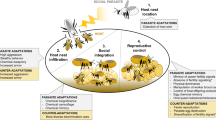Abstract
Cooperative breeding of animals is vulnerable to social parasitism, in which parasites usurp the labors of the hosts. In social hymenopterans, social parasitism has evolved numerous times independently, and the process by which it has arisen is thus a major question in evolutionary biology. It is generally thought that parasites originate from their hosts via sympatric speciation, and some actual examples have been reported. On the other hand, an alternative hypothesis that allopatric speciation first occurred, and then one species subsequently evolved as the parasite of its sister species has been theoretically supported, but no actual cases have yet been reported. Here, we report that our observations suggest facultative, temporary, and mutual social parasitism that occurs in both an intra- and interspecific manner in two sister species of yellow jackets, Vespula flaviceps and V. shidai, in Japan. Considering their parapatric distribution, social structure, and parasitic behaviors, social parasitism between these two species does not follow the conventional sympatric speciation hypothesis (intraspecific hypothesis), but possibly supports the social deception hypothesis (interspecific hypothesis). The mutual social parasitism between parapatric sister species offers a good opportunity to study the evolution of social parasitism.


Similar content being viewed by others
References
Berlocher SH (2003) When houseguests become parasites: sympatric speciation in ants. Proc Natl Acad Sci USA 100:6896–6898
Boomsma J, Nash D (2014) Evolution: sympatric speciation the eusocial way. Curr Biol 24:R798–R800
Buschinger A (2009) Social parasitism among ants: a review (Hymenoptera: Formicidae). Myrmecol News 12:219–235
Carpenter JM, Perera EP (2006) Phylogenetic relationships among yellow jackets and the evolution of social parasitism (Hymenoptera: Vespidae, Vespinae). Am Mus Novit 3507:1–19
Choudhary M, Strassmann JE, Queller DC, Turillazzi S, Cervo R (1994) Social parasites in polistine wasps are monophyletic: implications for sympatric speciation. Proc R Soc B 257:31–35
Emery C (1909) Über den Ursprung der dulotischen, parasitischen und myrmekophilen Ameisen. Biol Zent Bl 29:352–362
Greene A (1991) Dolichovespula and Vespula. In: Ross KG, Matthews RW (eds) The social biology of wasps. Cornell University Press, Ithaca, pp 263–305
Hines HM, Cameron SA (2010) The phylogenetic position of the bumble bee inquiline Bombus inexspectatus and implications for the evolution of social parasitism. Insectes Soc 57:379–383
Hölldobler B, Wilson EO (1990) The ants. Harvard University Press, Cambridge
Huber P (1861) Recherches sur les moeurs des fourmis indigenes. Paschoud, Paris
Lopez-Osorio F, Perrard A, Pickett KM, Carpenter JM, Agnarsson I (2015) Phylogenetic tests reject Emery’s rule in the evolution of social parasitism in yellow jackets and hornets (Hymenoptera: Vespidae, Vespinae). R Soc Open Sci 2:150–159
Lowe RM, Ward SA, Crozier RH (2002) The evolution of parasites from their hosts: intra- and interspecific parasitism and Emery’s rule. Proc R Soc B 269:1301–1305
MacDonald JF, Matthews RW (1975) Vespula squamosa: a yellow jacket wasp evolving toward parasitism. Science 190:1003–1004
MacDonald JF, Matthews RW, Jacobson RS (1980) Nesting biology of the yellowjacket, Vespula flavopilosa. J Kansas Entomol Soc 53:448–458
Matsuura M (1995) Social wasps of Japan in color. Hokkaido University Press, Sapporo (In Japanese with English summary)
Matsuura M, Yamane S (1990) Biology of the vespine wasps. Springer-Verlag, Berlin (translation of the 1984 book ‘comparative ethology of the vespine wasps,’ published by Hokkaido University Press, Sapporo, in Japanese)
Matthews RW, Matthews JR (1979) War of the yellow jacket queens. Nat His 88:56–65
Perrard A, Lopez-Osorio F, Carpenter JM (2015) Phylogeny, landmark analysis and the use of wing venation to study the evolution of social wasps (Hymenoptera: Vespidae: Vespinae). Cladistics. doi:10.1111/cla.12138
Rabeling C, Schultz TR, Pierce NE, Bacci M (2014) A social parasite evolved reproductive isolation from its fungus-growing ant host in sympatry. Curr Biol 24:2047–2052
Röseler PF (1991) Reproductive competition during colony establishment. In: Ross KG, Matthews RW (eds) The social biology of wasps. Cornell University Press, Ithaca, pp 389–425
Savolainen R, Vepsäläinen K (2003) Sympatric speciation through intraspecific social parasitism. Proc Natl Acad Sci USA 100:7169–7174
Shida T (1959) Social organization in Vespula. In: Imanishi K (ed) Societies and Individuals in the Animal. Iwanami-Syoten, Tokyo, pp 89–92 (in Japanese)
Smith JA, Tierney SM, Park YC, Fuller S, Schwarz MP (2007) Origins of social parasitism: the importance of divergence ages in phylogenetic studies. Mol Phylogenet Evol 43:1131–1137
Smith JA, Chenoweth LB, Tierney SM, Schwarz MP (2013) Repeated origins of social parasitism in allodapine bees indicate that the weak form of Emery’s rule is widespread, yet sympatric speciation remains highly problematic. Biol J Linn Soc 109:320–331
Starr CK (1979) Origin and evolution of insect sociality: a review of modern theory. In: Hermann HR (ed) Social insects, vol 1. Academic Press, New York, pp 35–79
Voveikov GS (1953) Estestvennaya smena samok vo cem’ya shmelej. (Hym., Bomb.). Entomol Obozr 33:174–184
Yamauchi T, Watanabe M (2009) Species compositions of social wasps (Hymenoptera: Vespidae) collected with Malaise traps at three different altitudes of Toyama Prefecture, Japan. Pestology 28:13–16 (in Japanese with English summary)
Acknowledgments
This research was supported in part by Takeda Science Foundation, Fujiwara Natural History Foundation, Funding of the Nagano Society for The Promotion of Science, and the Dream Project by Come on UP, Ltd. We are grateful to Koji Sasakawa and Yuichiro Kobayashi for discussion. We thank Honami Kawabe, Moe Takahashi, Chiaki Gomi, and Shuto Suzuki for their help with sample collection. We thank two anonymous reviewers whose comments improved the manuscript. We would like to thank Editage (www.editage.jp) for English language editing.
Author information
Authors and Affiliations
Corresponding author
Rights and permissions
About this article
Cite this article
Saga, T., Kanai, M., Shimada, M. et al. Mutual intra- and interspecific social parasitism between parapatric sister species of Vespula wasps. Insect. Soc. 64, 95–101 (2017). https://doi.org/10.1007/s00040-016-0519-6
Received:
Accepted:
Published:
Issue Date:
DOI: https://doi.org/10.1007/s00040-016-0519-6




